Summary: When you have recorded 4K videos using your GoPro camera and found the videos can’t be edited properly on a MacBook Pro Retina, especially in FCP and Premiere, check out these workarounds and troubleshooting tips below.
 Hot search: GoPro 4K Video to Pinnacle Studio | GoPro 4K Video to DVD Player | Play GoPro 4K Video on MacWe know that GoPro Hero cameras can capture professional-quality videos, for example Hero3 White can capture 1080p 30fps video, Hero3+ Silver can capture gorgeous 1080p 60fps video, Hero4 can take time lapse videos with high data rates, Hero4 Black can shoot incredible high-resolution 4K 30fps and 2.7K 60fps video and the high frame rate 1080p 120fps video.“I just shot a short movie on a GoPro Hero 4 Black camera and now it’s time to edit. It’s all shot in 4K MP4 and I’ll be editing on a MacBook Pro Retina 2.4GHz i7 with 8GB of ram. I’ve been editing with FCP but I’m tired of all the rendering all the time. How about Premiere handle things compared to FCP? I’ve heard that it can edit and view everything without rendering. Is that true? So should I get Premiere or stick with FCP? Is there any way around the problem?”FCP is a powerful but complicated video editor on Mac. Since you’ve got FCP already, I’ll shed you lights about importing GoPro 4K video to FCP for further editing without rendering. Before importing and editing, you should check out the supported format of FCP. As long as you import video files that FCP best accepted, these files can be recognized and successfully imported.Some main files formats recommended for Final Cut Pro:Video Formats: Apple Animation codec, Apple Intermediate codec, Apple ProRes(all versions), AVC-intra, AVCHD (including AVCCAM, AVCHD Lite, and NXCAM), DV (including DVCAM, DVCPRO, and DVCPRO50), DVCPRO HD, H.264, HDV, iFrame, Motion JPEG(OpenDML only), MPEG IMX(D-10), REDCODE RAW (R3D), Uncompressed 10-bit 4:2:2, Uncompressed 8-bit 4:2:2, XAVC, XDCAM HD/EX/HD422, QuickTime formats.Audio Formats: AAC, AIFF, BWF, CAF, MP3, MP4, WAVContainer Format: 3GP, AVI, MP4, MXF, QuickTimeStill-image Formats: BMP, GIF, JPEG, PNG, PSD, RAW, TGA, TIFFIn other words, only do we convert GoPro 4K video to FCP friendly format mentioned above, such as Apple ProRes, we can solve your rendering issues. So we could depend on Pavtube HD Video Converter for Mac (review) to rewrap GoPro 4K video to ProRes with fast conversion speed and high quality preserved. The one used here can meet your demands with its simple interface but rich functions.
Hot search: GoPro 4K Video to Pinnacle Studio | GoPro 4K Video to DVD Player | Play GoPro 4K Video on MacWe know that GoPro Hero cameras can capture professional-quality videos, for example Hero3 White can capture 1080p 30fps video, Hero3+ Silver can capture gorgeous 1080p 60fps video, Hero4 can take time lapse videos with high data rates, Hero4 Black can shoot incredible high-resolution 4K 30fps and 2.7K 60fps video and the high frame rate 1080p 120fps video.“I just shot a short movie on a GoPro Hero 4 Black camera and now it’s time to edit. It’s all shot in 4K MP4 and I’ll be editing on a MacBook Pro Retina 2.4GHz i7 with 8GB of ram. I’ve been editing with FCP but I’m tired of all the rendering all the time. How about Premiere handle things compared to FCP? I’ve heard that it can edit and view everything without rendering. Is that true? So should I get Premiere or stick with FCP? Is there any way around the problem?”FCP is a powerful but complicated video editor on Mac. Since you’ve got FCP already, I’ll shed you lights about importing GoPro 4K video to FCP for further editing without rendering. Before importing and editing, you should check out the supported format of FCP. As long as you import video files that FCP best accepted, these files can be recognized and successfully imported.Some main files formats recommended for Final Cut Pro:Video Formats: Apple Animation codec, Apple Intermediate codec, Apple ProRes(all versions), AVC-intra, AVCHD (including AVCCAM, AVCHD Lite, and NXCAM), DV (including DVCAM, DVCPRO, and DVCPRO50), DVCPRO HD, H.264, HDV, iFrame, Motion JPEG(OpenDML only), MPEG IMX(D-10), REDCODE RAW (R3D), Uncompressed 10-bit 4:2:2, Uncompressed 8-bit 4:2:2, XAVC, XDCAM HD/EX/HD422, QuickTime formats.Audio Formats: AAC, AIFF, BWF, CAF, MP3, MP4, WAVContainer Format: 3GP, AVI, MP4, MXF, QuickTimeStill-image Formats: BMP, GIF, JPEG, PNG, PSD, RAW, TGA, TIFFIn other words, only do we convert GoPro 4K video to FCP friendly format mentioned above, such as Apple ProRes, we can solve your rendering issues. So we could depend on Pavtube HD Video Converter for Mac (review) to rewrap GoPro 4K video to ProRes with fast conversion speed and high quality preserved. The one used here can meet your demands with its simple interface but rich functions.
 Other Download:- Pavtube old official address: http://www.pavtube.com/hd-video-converter-mac/- Amazon Store Download: http://www.amazon.com/Pavtube-Video-Converter-Mac-Download/dp/B00QI9GNZS- AppStore Download: https://itunes.apple.com/de/app/pavtube-hd-video-converter/id502792488?mt=12- Cnet Download: http://download.cnet.com/Pavtube-HD-Video-Converter/3000-2194_4-76177786.htmlHow to edit GoPro 4K video in FCP on a MacBook Pro Retina?Step 1: Download and have a quick installation. The trial version will have a watermark on your converted files. Except for that, there are no time limitation, no virus, and no unnecessary bundle apps while downloading. After that, click “Add Video” button to load your original files. You can load several files at once thanks to “Add from folder” button.
Other Download:- Pavtube old official address: http://www.pavtube.com/hd-video-converter-mac/- Amazon Store Download: http://www.amazon.com/Pavtube-Video-Converter-Mac-Download/dp/B00QI9GNZS- AppStore Download: https://itunes.apple.com/de/app/pavtube-hd-video-converter/id502792488?mt=12- Cnet Download: http://download.cnet.com/Pavtube-HD-Video-Converter/3000-2194_4-76177786.htmlHow to edit GoPro 4K video in FCP on a MacBook Pro Retina?Step 1: Download and have a quick installation. The trial version will have a watermark on your converted files. Except for that, there are no time limitation, no virus, and no unnecessary bundle apps while downloading. After that, click “Add Video” button to load your original files. You can load several files at once thanks to “Add from folder” button.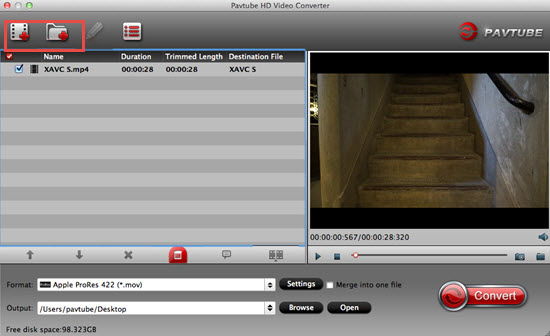 Step 2: Click the “Format” bar to get the drop-down menu and you can get “Final Cut Pro”. Choose “Apple ProRes 422 (*.mov)” as output format.
Step 2: Click the “Format” bar to get the drop-down menu and you can get “Final Cut Pro”. Choose “Apple ProRes 422 (*.mov)” as output format.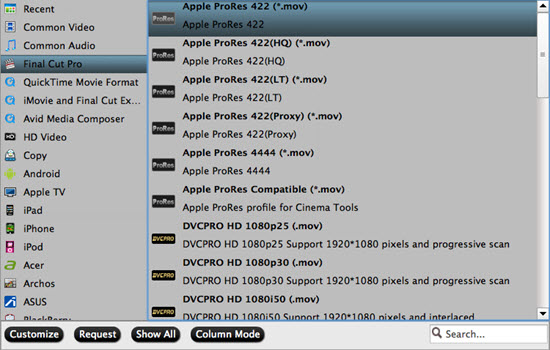 Step 3: Click “Settings” button to customize the output video and audio settings by yourself. But if you are not good at it, you’d better use the default parameters, they will ensure you a good balance between file size and image quality basically. You can change the resolution, bit rate, frame rate as you need.Step 4: Click “Convert” button on the bottom of the screen to start GoPro 4K video to ProRes 422 MOV conversion process. The amount of time it takes will vary based on your system’s hardware and the quality settings you selected.
Step 3: Click “Settings” button to customize the output video and audio settings by yourself. But if you are not good at it, you’d better use the default parameters, they will ensure you a good balance between file size and image quality basically. You can change the resolution, bit rate, frame rate as you need.Step 4: Click “Convert” button on the bottom of the screen to start GoPro 4K video to ProRes 422 MOV conversion process. The amount of time it takes will vary based on your system’s hardware and the quality settings you selected.
Conclusion: When the conversion is done, you can click “Open” button to get the generated video files. Now, you can edit GoPro 4K video in FCP on a MacBook Pro Retina freely.Further Reading:
Summary: How to make Avid Media Composer works well with 4K MXF clips from Canon C300 Mark II? If you are puzzled with this question, you may find a satisfactory answer in this post. It explains a best way to convert 4K MXF to DNxHD MOV for editing in Avid MC smoothly.
 Hot search: 4K MXF to YouTube/Vimeo/Facebook | 4K MXF to DaVinci Resolve | 4K MXF to Sony Vegas | 4K MXF to After EffectsCanon C300 Mark II is a hot camcorder on the market, since it released it has attracted great attention due to its excellent hardware equipment. It features a Super 35mm CMOS sensor, which will help you to record 4K, 1920*1080 60/50i, 23.98/25p True 24p videos. Besides Canon C300 Mark II uses Dual Pixel CMOS AF technology. This provides faster and more accurate autofocusing to assist users when operating with small crews. With C300 Mark II you can record high quality videos, it delivers the highest image quality with its XF Codec–the same codec used by other Canon XF professional camcorders.Though Canon C300 Mark II camcorder can help you to record high quality 4K MXF footages, but usually it can make video editing a real nightmare. “I’ve got a ton of Canon C300 Mark II footage that I’m trying to import the C300 Mark II MXF files into Avid MC 7. Since the files come out natively as MXF, I know I can pull them right into Avid, but the file structure coming off the card, it has been presenting issues.”Many Canon high-end camcorder users have the need to edit recorded MXF files in Avid Media Composer, but sometime it is not easy to import 4K MXF files to Avid, because the MXF video codec is not native for Avid Media Composer. Avid MC usually said the C300 Mark II 4K MXF files are not supported, so you can’t import and edit Canon C300 Mark II 4K MXF files with Avid smoothly.Main Supported Video Formats for Avid Media Composer:DNxHD: This is Avid’s baby. All kinds of DNxHD are supported natively via either of the import methods mentioned above.H.264: H.264 is the ubiquitous codec, and it looks like it will stay for quite some time. Avid Media Composer supports H.264 natively, via AMA as mentioned above.MPEG-4: Like H.264, Avid Media Composer supports MPEG-4 natively, via AMA as mentioned above. The QuickTime plug-ins are installed by default.In this case, what’s the best solution to import and edit C300 Mark II 4K MXF files with Avid MC? Absolutely, it’s to convert 4K MXF to DNxHD, native supported video format for Avid Media Composer as mentioned above. The process is surprisingly easy and can be done with the help of Pavtube iMixMXF. With this program, you can effortlessly encode/re-encode Canon C300 Mark II 4K MXF footage for smoothly importing and editing in various NLEs.
Hot search: 4K MXF to YouTube/Vimeo/Facebook | 4K MXF to DaVinci Resolve | 4K MXF to Sony Vegas | 4K MXF to After EffectsCanon C300 Mark II is a hot camcorder on the market, since it released it has attracted great attention due to its excellent hardware equipment. It features a Super 35mm CMOS sensor, which will help you to record 4K, 1920*1080 60/50i, 23.98/25p True 24p videos. Besides Canon C300 Mark II uses Dual Pixel CMOS AF technology. This provides faster and more accurate autofocusing to assist users when operating with small crews. With C300 Mark II you can record high quality videos, it delivers the highest image quality with its XF Codec–the same codec used by other Canon XF professional camcorders.Though Canon C300 Mark II camcorder can help you to record high quality 4K MXF footages, but usually it can make video editing a real nightmare. “I’ve got a ton of Canon C300 Mark II footage that I’m trying to import the C300 Mark II MXF files into Avid MC 7. Since the files come out natively as MXF, I know I can pull them right into Avid, but the file structure coming off the card, it has been presenting issues.”Many Canon high-end camcorder users have the need to edit recorded MXF files in Avid Media Composer, but sometime it is not easy to import 4K MXF files to Avid, because the MXF video codec is not native for Avid Media Composer. Avid MC usually said the C300 Mark II 4K MXF files are not supported, so you can’t import and edit Canon C300 Mark II 4K MXF files with Avid smoothly.Main Supported Video Formats for Avid Media Composer:DNxHD: This is Avid’s baby. All kinds of DNxHD are supported natively via either of the import methods mentioned above.H.264: H.264 is the ubiquitous codec, and it looks like it will stay for quite some time. Avid Media Composer supports H.264 natively, via AMA as mentioned above.MPEG-4: Like H.264, Avid Media Composer supports MPEG-4 natively, via AMA as mentioned above. The QuickTime plug-ins are installed by default.In this case, what’s the best solution to import and edit C300 Mark II 4K MXF files with Avid MC? Absolutely, it’s to convert 4K MXF to DNxHD, native supported video format for Avid Media Composer as mentioned above. The process is surprisingly easy and can be done with the help of Pavtube iMixMXF. With this program, you can effortlessly encode/re-encode Canon C300 Mark II 4K MXF footage for smoothly importing and editing in various NLEs.
 Other Download: - Pavtube old official address: http://www.pavtube.com/imixmxf-mac/- Amazon Download: http://www.amazon.com/Pavtube-Studio-iMixMXF-Download/dp/B00QI7MY4Y- Cnet Download: http://download.cnet.com/Pavtube-iMixMXF/3000-2194_4-76171460.htmlHow to convert Canon C300 Mark II 4K MXF to Avid MC on Mac?Step 1: Download and install the program from the website or click the free trial icon. Then, launch the best iMixMXF and load your original MXF files in with “Add video” or “Add from folder”. Directly drag files in is available.
Other Download: - Pavtube old official address: http://www.pavtube.com/imixmxf-mac/- Amazon Download: http://www.amazon.com/Pavtube-Studio-iMixMXF-Download/dp/B00QI7MY4Y- Cnet Download: http://download.cnet.com/Pavtube-iMixMXF/3000-2194_4-76171460.htmlHow to convert Canon C300 Mark II 4K MXF to Avid MC on Mac?Step 1: Download and install the program from the website or click the free trial icon. Then, launch the best iMixMXF and load your original MXF files in with “Add video” or “Add from folder”. Directly drag files in is available.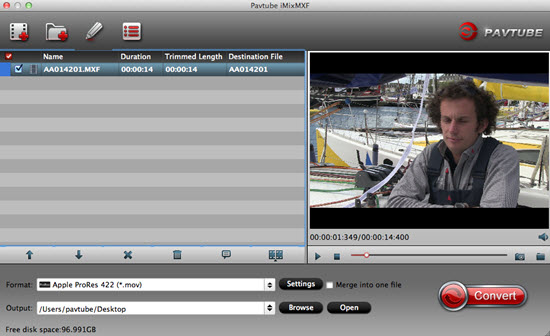 Step 2: Click the “Format” bar to get the drop-down menu and you can get “Avid Media Composer>>Avid DNxHD”.
Step 2: Click the “Format” bar to get the drop-down menu and you can get “Avid Media Composer>>Avid DNxHD”.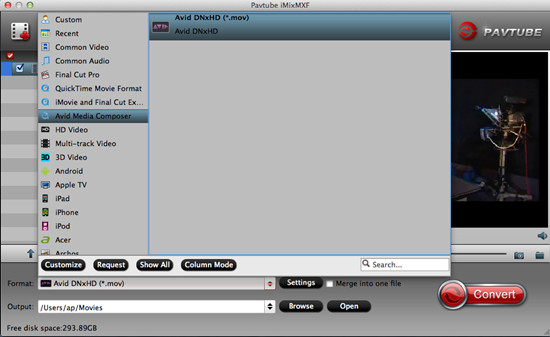 Step 3: Click “Settings” button to customize the output video and audio settings by yourself. But if you are not good at it, you’d better use the default parameters, they will ensure you a good balance between file size and image quality basically. You can change the resolution, bit rate, frame rate as you need.Step 4: Click the “Convert” button on the main interface if you have done all the preparation work. This is the workflow that we need to convert 4K MXF to DNxHD.Conclusion: OK, everything is ready, you can get the generated files by clicking “Open” button and instantly edit Canon C300 Mark II 4K MXF files in Avid MC.Further Reading:
Step 3: Click “Settings” button to customize the output video and audio settings by yourself. But if you are not good at it, you’d better use the default parameters, they will ensure you a good balance between file size and image quality basically. You can change the resolution, bit rate, frame rate as you need.Step 4: Click the “Convert” button on the main interface if you have done all the preparation work. This is the workflow that we need to convert 4K MXF to DNxHD.Conclusion: OK, everything is ready, you can get the generated files by clicking “Open” button and instantly edit Canon C300 Mark II 4K MXF files in Avid MC.Further Reading:
Summary: When you transfer your recorded shows by TiVo, you’ll find these files are not so easy to play back and edit as common video files. There is a way to fix it, converting TiVo to something more common. Converting TiVo to AVI for watching is highly recommended.
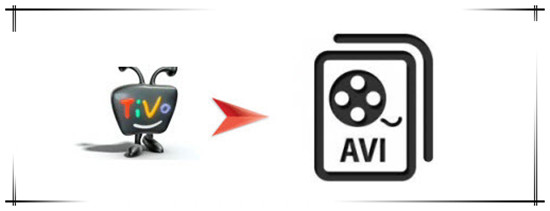 TiVo, the professional digital video recorder, provides us with marvelous videos, TV shows, and movies. However, we often meet the issue that TiVo videos cannot be played on Windows, Mac, media players or be transferred to portable devices or be edited in video editing tools. It is quite hard to upload TiVo videos to YouTube or burn TiVo files to DVDs. As a matter of fact, all these issues are caused by the file format compatibility.As a result, it is required to convert the TiVo files to a decent format you need on your computer. One common movie file type is AVI. A video file has two parts: a container and a codec. The container packages the video and all of its other components, such as audio and metadata, and provides the identification of the file extension, which could be AVI. The container is the structure of the file, including how the different elements of the movie are stored and how they interconnect. The codec is the device that encodes the audio or video into the stream of bytes. Simply put, the container is the file and the codec is the contents. Most container formats can hold many different types of codecs.When you import the file to either edit or play, the software reading the file has to know how to draw out the different codecs, or different parts of the file, in order to play. When a program does not recognize a file type, then you run into problems and have to convert the file to a compatible file. So, how to convert TiVo to AVI with high quality for watching?Don’t bother trying sorts of TiVo hacking methods, there is easier way to go! Pavtube Video Converter (Mac version) can help you achieve your goal smoothly. In fact, this TiVo Converter is an all-in-one video convert app. It can help you quickly and easily convert TiVo to any format like MP4, MKV, AVI, WMV, MOV, MPG, M4V and etc. with least quality loss. Besides TiVo, this video convert program can also help to convert between any popular video and audio formats as you need. You could get wonderful output files and never worry about out of audio/video sync. Plus, with the built-in video editing feature of the program, you can trim, crop, add watermark, add subtitle and more to your video files.
TiVo, the professional digital video recorder, provides us with marvelous videos, TV shows, and movies. However, we often meet the issue that TiVo videos cannot be played on Windows, Mac, media players or be transferred to portable devices or be edited in video editing tools. It is quite hard to upload TiVo videos to YouTube or burn TiVo files to DVDs. As a matter of fact, all these issues are caused by the file format compatibility.As a result, it is required to convert the TiVo files to a decent format you need on your computer. One common movie file type is AVI. A video file has two parts: a container and a codec. The container packages the video and all of its other components, such as audio and metadata, and provides the identification of the file extension, which could be AVI. The container is the structure of the file, including how the different elements of the movie are stored and how they interconnect. The codec is the device that encodes the audio or video into the stream of bytes. Simply put, the container is the file and the codec is the contents. Most container formats can hold many different types of codecs.When you import the file to either edit or play, the software reading the file has to know how to draw out the different codecs, or different parts of the file, in order to play. When a program does not recognize a file type, then you run into problems and have to convert the file to a compatible file. So, how to convert TiVo to AVI with high quality for watching?Don’t bother trying sorts of TiVo hacking methods, there is easier way to go! Pavtube Video Converter (Mac version) can help you achieve your goal smoothly. In fact, this TiVo Converter is an all-in-one video convert app. It can help you quickly and easily convert TiVo to any format like MP4, MKV, AVI, WMV, MOV, MPG, M4V and etc. with least quality loss. Besides TiVo, this video convert program can also help to convert between any popular video and audio formats as you need. You could get wonderful output files and never worry about out of audio/video sync. Plus, with the built-in video editing feature of the program, you can trim, crop, add watermark, add subtitle and more to your video files.
 Other Download:- Pavtube old official address: http://www.pavtube.com/video_converter/- Amazon Download: http://download.cnet.com/Pavtube-Video-Converter/3000-2194_4-75734821.html- Cnet Download: http://download.cnet.com/Pavtube-Video-Converter/3000-2194_4-75734821.htmlRefer to the below guide for converting TiVo to AVI:Step 1: Download and install the corresponding program. Press “Options” button. Switch to “TiVo” tab in Option window and enter TiVo Media Access Key.
Other Download:- Pavtube old official address: http://www.pavtube.com/video_converter/- Amazon Download: http://download.cnet.com/Pavtube-Video-Converter/3000-2194_4-75734821.html- Cnet Download: http://download.cnet.com/Pavtube-Video-Converter/3000-2194_4-75734821.htmlRefer to the below guide for converting TiVo to AVI:Step 1: Download and install the corresponding program. Press “Options” button. Switch to “TiVo” tab in Option window and enter TiVo Media Access Key.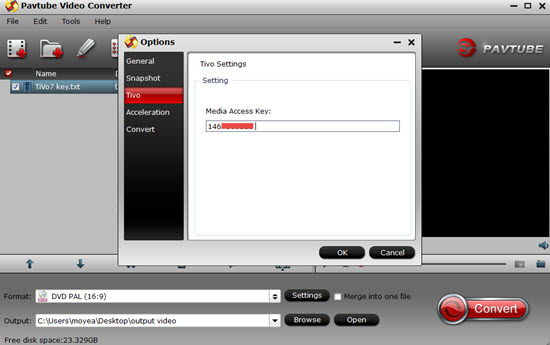 Tips: How to find your Media Access Key on TiVo? Go to “TiVo Central”> “Messages and Set Up” “Account and System Information”, and your Media Access Key would be there.Step 2: Click “Add video” button to load TiVo files to the program. You can load several files at once thanks to “Add from folder” button. Or you can drag and drop TiVo files to the main interface directly.
Tips: How to find your Media Access Key on TiVo? Go to “TiVo Central”> “Messages and Set Up” “Account and System Information”, and your Media Access Key would be there.Step 2: Click “Add video” button to load TiVo files to the program. You can load several files at once thanks to “Add from folder” button. Or you can drag and drop TiVo files to the main interface directly.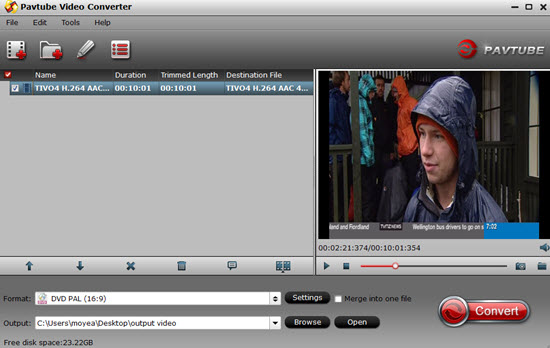 Step 3: Click “Format” bar and select “HD Video>>AVI HD Video (*.avi)” as best output format.
Step 3: Click “Format” bar and select “HD Video>>AVI HD Video (*.avi)” as best output format. Step 4: Press “Convert” button to convert TiVo to AVI for watching with high quality.Conclusion: When the conversion is done, you can click “Open” to get your generated files. There is no need to worry about how to convert TiVo to AVI with high quality preserved for watching and enjoying!Further Reading:
Step 4: Press “Convert” button to convert TiVo to AVI for watching with high quality.Conclusion: When the conversion is done, you can click “Open” to get your generated files. There is no need to worry about how to convert TiVo to AVI with high quality preserved for watching and enjoying!Further Reading:
Summary: This article mainly talks about the way to convert Panasonic DMC-G7 4K to iMovie/FCE for editing. Keep reading to learn how to.
 Panasonic has introduced the G7 to replace the G6, and it sits just below the Panasonic GH4–but alongside the GX7. That's a lot of G numbers, but basically, the G7 is the company's mid-range compact system camera. Formerly the preserve of professional filmmakers and photographers, LUMIX G7 is opening up the world of 4K to everyone. Whether you're making movie memories to last a lifetime, or taking amazing stills from your 4K footage, the G7 is changing photography, for good.With Panasonic DMC-G7, you can record 4K MP4 video and Full HD AVCHD video easily. 4K footage looks amazing but if you don’t have a fast computer with a high end RAM and speedy processor it can make video editing a real nightmare. Your computer may freeze or crash when editing G7 4K MP4 in iMovie/FCE.iMovie is one of the best video editing tools for Mac. With it, you can beautify your videos simply by cutting, cropping, merging, adding effects etc. to them. It works stable on Mac computer, so it's loved by millions of users. On the official site, it says iMovie 11 can support DV, MPEG-4, MPEG-2, MOV and M4V file types. According to this, you are enabled to import MP4 to iMovie. Thus, why iMovie 11 fails to recognize some MP4 videos? You'd better to know the reason clearly in order to avoid stumbling upon the same trouble repeatedly.First and foremost, I wanna tell you that iMovie only accepts MP4 file which contains MPEG-4 and H.264 codecs. While, the audio, subtitle or other media source that embed in MP4 might have different codecs. In this case, we cannot judge the video format by examining the file extension name only. So it is impossible for the MP4 file to determine the type of streams in an MPEG-4 file based on its filename extension alone. Therefore, you may have some clues that why people using Mac always meet difficulty in importing MP4 to iMovie.All in all, to smoothly import DMC-G7 4K MP4 files to iMovie/FCE, you'd better to convert these MP4 files to iMovie/FCE totally compatible formats as we searched above. To get the job well done, we need to use an all-in-one program-Pavtube HD Video Converter for Mac. With it, you can effortlessly encode/re-encode Panasonic G7 4K MP4 footage for smoothly importing and editing in various non-linear editing systems, including FCP, Adobe Premiere Pro, Avid Media Composer and more.
Panasonic has introduced the G7 to replace the G6, and it sits just below the Panasonic GH4–but alongside the GX7. That's a lot of G numbers, but basically, the G7 is the company's mid-range compact system camera. Formerly the preserve of professional filmmakers and photographers, LUMIX G7 is opening up the world of 4K to everyone. Whether you're making movie memories to last a lifetime, or taking amazing stills from your 4K footage, the G7 is changing photography, for good.With Panasonic DMC-G7, you can record 4K MP4 video and Full HD AVCHD video easily. 4K footage looks amazing but if you don’t have a fast computer with a high end RAM and speedy processor it can make video editing a real nightmare. Your computer may freeze or crash when editing G7 4K MP4 in iMovie/FCE.iMovie is one of the best video editing tools for Mac. With it, you can beautify your videos simply by cutting, cropping, merging, adding effects etc. to them. It works stable on Mac computer, so it's loved by millions of users. On the official site, it says iMovie 11 can support DV, MPEG-4, MPEG-2, MOV and M4V file types. According to this, you are enabled to import MP4 to iMovie. Thus, why iMovie 11 fails to recognize some MP4 videos? You'd better to know the reason clearly in order to avoid stumbling upon the same trouble repeatedly.First and foremost, I wanna tell you that iMovie only accepts MP4 file which contains MPEG-4 and H.264 codecs. While, the audio, subtitle or other media source that embed in MP4 might have different codecs. In this case, we cannot judge the video format by examining the file extension name only. So it is impossible for the MP4 file to determine the type of streams in an MPEG-4 file based on its filename extension alone. Therefore, you may have some clues that why people using Mac always meet difficulty in importing MP4 to iMovie.All in all, to smoothly import DMC-G7 4K MP4 files to iMovie/FCE, you'd better to convert these MP4 files to iMovie/FCE totally compatible formats as we searched above. To get the job well done, we need to use an all-in-one program-Pavtube HD Video Converter for Mac. With it, you can effortlessly encode/re-encode Panasonic G7 4K MP4 footage for smoothly importing and editing in various non-linear editing systems, including FCP, Adobe Premiere Pro, Avid Media Composer and more.
 Other Download:- Pavtube old official address: http://www.pavtube.com/hd-video-converter-mac/- Amazon Store Download: http://www.amazon.com/Pavtube-Video-Converter-Mac-Download/dp/B00QI9GNZS- AppStore Download: https://itunes.apple.com/de/app/pavtube-hd-video-converter/id502792488?mt=12- Cnet Download: http://download.cnet.com/Pavtube-HD-Video-Converter/3000-2194_4-76177786.htmlHow to edit Panasonic DMC-G7 4K MP4 in iMovie/FCE?Step 1: Download and have a quick installation. The trial version will have a watermark on your converted files.Except for that, there are no time limitation, no virus, and no unnecessary bundle apps while downloading. After that, click “Add Video” button to load your 4K MP4 files. You can load several files at once thanks to “Add from folder” button.
Other Download:- Pavtube old official address: http://www.pavtube.com/hd-video-converter-mac/- Amazon Store Download: http://www.amazon.com/Pavtube-Video-Converter-Mac-Download/dp/B00QI9GNZS- AppStore Download: https://itunes.apple.com/de/app/pavtube-hd-video-converter/id502792488?mt=12- Cnet Download: http://download.cnet.com/Pavtube-HD-Video-Converter/3000-2194_4-76177786.htmlHow to edit Panasonic DMC-G7 4K MP4 in iMovie/FCE?Step 1: Download and have a quick installation. The trial version will have a watermark on your converted files.Except for that, there are no time limitation, no virus, and no unnecessary bundle apps while downloading. After that, click “Add Video” button to load your 4K MP4 files. You can load several files at once thanks to “Add from folder” button. Step 2: Click the “Format” bar to get the drop-down menu and you can get “iMovie and Final Cut Express”. Choose “Apple InterMediate Codec (AIC) (*.mov)” as output format.
Step 2: Click the “Format” bar to get the drop-down menu and you can get “iMovie and Final Cut Express”. Choose “Apple InterMediate Codec (AIC) (*.mov)” as output format.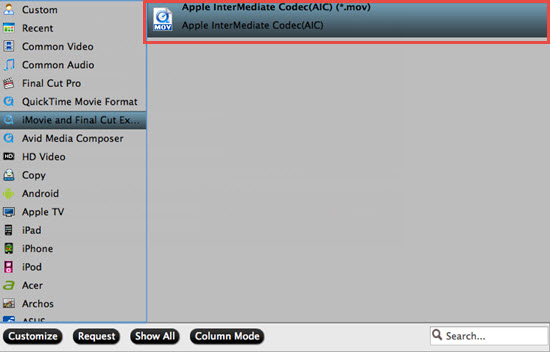 Step 3: Click “Settings” button to customize the output video and audio settings by yourself. But if you are not good at it, you’d better use the default parameters, they will ensure you a good balance between file size and image quality basically. You can change the resolution, bit rate, frame rate as you need.Step 4: Click “Convert” button on the bottom of the screen to start 4K MP4 to AIC MOV conversion process. The amount of time it takes will vary based on your system’s hardware and the quality settings you selected.Conclusion: When the conversion is done, you can click “Open” to get your generated files. Now, you can edit DMC-G7 4K files in iMovie/FCE without any hassles.Further Reading:
Step 3: Click “Settings” button to customize the output video and audio settings by yourself. But if you are not good at it, you’d better use the default parameters, they will ensure you a good balance between file size and image quality basically. You can change the resolution, bit rate, frame rate as you need.Step 4: Click “Convert” button on the bottom of the screen to start 4K MP4 to AIC MOV conversion process. The amount of time it takes will vary based on your system’s hardware and the quality settings you selected.Conclusion: When the conversion is done, you can click “Open” to get your generated files. Now, you can edit DMC-G7 4K files in iMovie/FCE without any hassles.Further Reading:
Summary: With the Phantom 2 Vision+, you can records MP4 formats, but most users may find a problem when converting DJI Phantom 2 Vision+ MP4 to Magix Video Pro X for editing. These MP4 files are clunky to edit requiring much rendering when in a Magix Video Pro X timeline.
 As we know, MP4 is widely used for saving media datum. And it can be found in lots of places, such as camcorders (GoPro/Sony or other camcorders), websites (YouTube/Fox or other Video websites) and even the newly aerial apparatus like DJI Phantom 2 Vision+. It is a common video format for users to share.Although MP4 is in the supported file formats of Magix Video Pro X, sometimes, you will find it's not easy to import MP4 to Magix Video Pro X for editing. There are some video or audio codec problems when you try to use a MP4 file in Magix Video Pro even with the latest version. Actually, this is due to the MP4 files codec: Magix Video Pro X only accept MPEG-4 codec instead of others. While, MP4 is a container format which hold various video and audio codecs and that's why you will encounter problems when you attempt to edit MP4 videos in Magix Video Pro X.Afterwards, when you got a pile of MP4 files from different source, there’s no luck Magix Video Pro X can support all of your MP4 media. To fix the problem, you can try to install MP4 codecs for Magix Video Pro X. If the method does not work, there is also an easy way to fix the issue. The easy option is to convert DJI Phantom 2 Vision+ H.264 MP4 to Magix Video Pro X supported file format like MPEG-4 MP4. Actually, it's not as difficult as you imagine. What's need is just a common video converter like Pavtube Video Converter, which can help you transcode H.264 MP4 to MPEG-4 MP4 with maximum editing quality and efficiency when working with Magix Video Pro X under Windows operating system.
As we know, MP4 is widely used for saving media datum. And it can be found in lots of places, such as camcorders (GoPro/Sony or other camcorders), websites (YouTube/Fox or other Video websites) and even the newly aerial apparatus like DJI Phantom 2 Vision+. It is a common video format for users to share.Although MP4 is in the supported file formats of Magix Video Pro X, sometimes, you will find it's not easy to import MP4 to Magix Video Pro X for editing. There are some video or audio codec problems when you try to use a MP4 file in Magix Video Pro even with the latest version. Actually, this is due to the MP4 files codec: Magix Video Pro X only accept MPEG-4 codec instead of others. While, MP4 is a container format which hold various video and audio codecs and that's why you will encounter problems when you attempt to edit MP4 videos in Magix Video Pro X.Afterwards, when you got a pile of MP4 files from different source, there’s no luck Magix Video Pro X can support all of your MP4 media. To fix the problem, you can try to install MP4 codecs for Magix Video Pro X. If the method does not work, there is also an easy way to fix the issue. The easy option is to convert DJI Phantom 2 Vision+ H.264 MP4 to Magix Video Pro X supported file format like MPEG-4 MP4. Actually, it's not as difficult as you imagine. What's need is just a common video converter like Pavtube Video Converter, which can help you transcode H.264 MP4 to MPEG-4 MP4 with maximum editing quality and efficiency when working with Magix Video Pro X under Windows operating system.
 Several simple clicks to convert DJI Phantom 2 Vision+ video to Magix Video Pro X:Step 1: Download and follow the prompts to install the program. When the installation is complete, the best DJI Phantom 2 Vision+ MP4 Converter will launch automatically.Step 2: Click “Add video” button to load DJI Phantom 2 Vision+ H.264 MP4 recordings or directly drag the files into file list. By default, the files are selected. You can delete files which you don’t want to import to.
Several simple clicks to convert DJI Phantom 2 Vision+ video to Magix Video Pro X:Step 1: Download and follow the prompts to install the program. When the installation is complete, the best DJI Phantom 2 Vision+ MP4 Converter will launch automatically.Step 2: Click “Add video” button to load DJI Phantom 2 Vision+ H.264 MP4 recordings or directly drag the files into file list. By default, the files are selected. You can delete files which you don’t want to import to.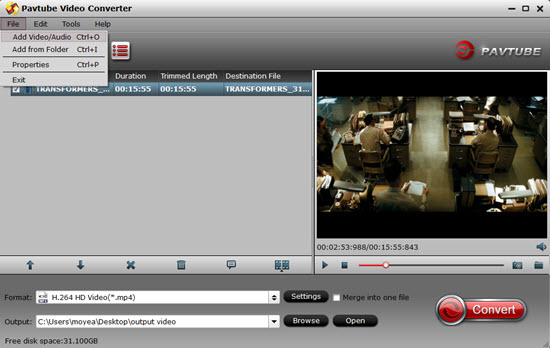 Step 3: Click “Format” bar to determine output format. For best image quality, click the format bar and choose “HD Video>>MPEG-4 HD Video (*.mp4)” as output format.
Step 3: Click “Format” bar to determine output format. For best image quality, click the format bar and choose “HD Video>>MPEG-4 HD Video (*.mp4)” as output format. Step 4: Click “Settings” button to customize the output video and audio settings by yourself. But if you are not good at it, you’d better use the default parameters, they will ensure you a good balance between file size and image quality basically. You can change the resolution, bit rate, frame rate as you need.Step 5: You can preview to check the final result. Once you are satisfied with it, click the “Convert” button to start converting DJI Phantom 2 Vision+ H.264 MP4 to MPEG-4 MP4 for editing in Magix Video Pro X flawlessly. It will take you a little while.Conclusion: Once the conversion process is complete, you can click “Open Folder” button to get the generated files for editing DJI Phantom 2 Vision+ H.264 MP4 in Magix Video Pro X with optimum performance. Good news about Father’s Day event! Why not seize the chance to buy fantastic goods with attractive price?Further Reading:
Step 4: Click “Settings” button to customize the output video and audio settings by yourself. But if you are not good at it, you’d better use the default parameters, they will ensure you a good balance between file size and image quality basically. You can change the resolution, bit rate, frame rate as you need.Step 5: You can preview to check the final result. Once you are satisfied with it, click the “Convert” button to start converting DJI Phantom 2 Vision+ H.264 MP4 to MPEG-4 MP4 for editing in Magix Video Pro X flawlessly. It will take you a little while.Conclusion: Once the conversion process is complete, you can click “Open Folder” button to get the generated files for editing DJI Phantom 2 Vision+ H.264 MP4 in Magix Video Pro X with optimum performance. Good news about Father’s Day event! Why not seize the chance to buy fantastic goods with attractive price?Further Reading:
Summary: How to import Canon C100 MTS to Premiere/Sony Vegas? There’s no native way to do this—and I’ll give an alternative method to import MTS from C100 to Premiere/Sony Vegas for editing without any loss.
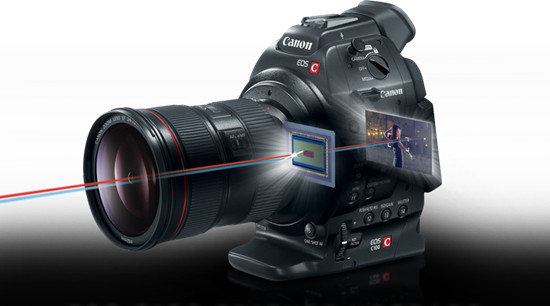 There is a well documented bug with editing long AVCHD clips in Premiere/Sony Vegas. One of the affected camera is the C100. Adobe acknowledged the existence the bug some time ago and although they final announced that they are committed to fixing the bug. However, it’s still painful experience for C100 owners who want to edit Canon C100 MTS footage in Premiere Pro, as so many issues still exist.Q: “I just installed the new updates and tried to start a new project in Premiere CC and import MTS files. I get an error message saying ‘The file has an unsupported compression type.’ I’m really excited about all the new features in this update and want to be able to use them for work but right now I'm super disappointed.”Sometimes, if you are currently using an older version of the Adobe (for instance prior to Adobe version CS5), maybe an upgrade of the Adobe version could help. Still stuck with unsuccessful attempts? Perhaps there is some required codec missing or it is an incompatible video file format.Actually, it’s not so hard to do the trick. Why we always have trouble editing because Premiere Pro still cannot accept all codecs contained in an MTS file to go natively. From Adobe Premiere Pro supported file formats list, you may get some clues about how to successfully import C100 MTS to Premiere. There is no doubt to convert MTS to MPEG-2, which is best accepted by Premiere as well as Sony Vegas. Read related posts about the MTS to Premiere/Sony Vegas issue, some guys recommend the Media Browser, so I tried that instead of dragging MTS files into Adobe Premiere. Unfortunately it still does not work. To get rid of the issue, transcoding MTS files to Premiere/Sony Vegas from C100 is recommended an efficient and ultimate workaround. Here you can depend on Pavtube MTS/M2TS Converter, an easy-to-use yet powerful high-quality MTS converter, player and editor under Windows operation system.
There is a well documented bug with editing long AVCHD clips in Premiere/Sony Vegas. One of the affected camera is the C100. Adobe acknowledged the existence the bug some time ago and although they final announced that they are committed to fixing the bug. However, it’s still painful experience for C100 owners who want to edit Canon C100 MTS footage in Premiere Pro, as so many issues still exist.Q: “I just installed the new updates and tried to start a new project in Premiere CC and import MTS files. I get an error message saying ‘The file has an unsupported compression type.’ I’m really excited about all the new features in this update and want to be able to use them for work but right now I'm super disappointed.”Sometimes, if you are currently using an older version of the Adobe (for instance prior to Adobe version CS5), maybe an upgrade of the Adobe version could help. Still stuck with unsuccessful attempts? Perhaps there is some required codec missing or it is an incompatible video file format.Actually, it’s not so hard to do the trick. Why we always have trouble editing because Premiere Pro still cannot accept all codecs contained in an MTS file to go natively. From Adobe Premiere Pro supported file formats list, you may get some clues about how to successfully import C100 MTS to Premiere. There is no doubt to convert MTS to MPEG-2, which is best accepted by Premiere as well as Sony Vegas. Read related posts about the MTS to Premiere/Sony Vegas issue, some guys recommend the Media Browser, so I tried that instead of dragging MTS files into Adobe Premiere. Unfortunately it still does not work. To get rid of the issue, transcoding MTS files to Premiere/Sony Vegas from C100 is recommended an efficient and ultimate workaround. Here you can depend on Pavtube MTS/M2TS Converter, an easy-to-use yet powerful high-quality MTS converter, player and editor under Windows operation system.
 How to import C100 MTS to Premiere/Sony Vegas for editing?Step 1: Download MTS/M2TS Converter, and follow the prompts to install the program. When the installation is complete, the best program will launch automatically.Step 2: Click “Add video” button to load C100 MTS files or directly drag the files into file list. By default, the files are selected. You can delete files which you don’t want to import to.
How to import C100 MTS to Premiere/Sony Vegas for editing?Step 1: Download MTS/M2TS Converter, and follow the prompts to install the program. When the installation is complete, the best program will launch automatically.Step 2: Click “Add video” button to load C100 MTS files or directly drag the files into file list. By default, the files are selected. You can delete files which you don’t want to import to.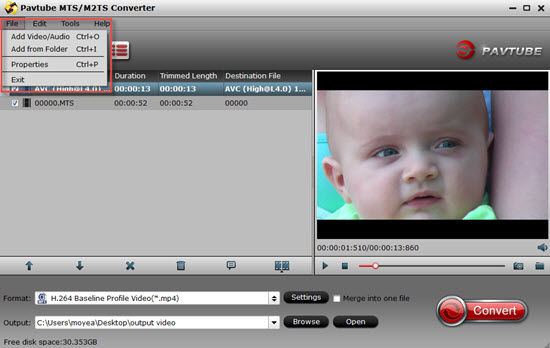 Step 3: Click “Format” bar to determine output format. For best image quality, click the format bar and choose “Adobe Premiere/Sony Vegas>>MPEG-2 (*.mpg)” as output format.
Step 3: Click “Format” bar to determine output format. For best image quality, click the format bar and choose “Adobe Premiere/Sony Vegas>>MPEG-2 (*.mpg)” as output format.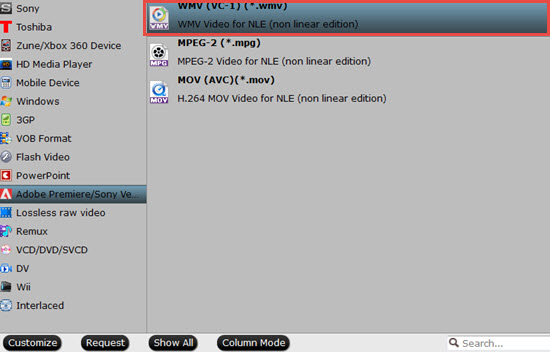 Step 4: Click “Convert” button to start to convert C100 MTS to MPEG-2 MPG format. After conversion, import the converted MTS videos to Premiere/Sony Vegas for real time editing and mastering.Conclusion: You can set auto shutdown in progress window or leave it there and come back later. There is no more difficulty in editing C100 MTS in Premiere and Sony Vegas.Further Reading:
Step 4: Click “Convert” button to start to convert C100 MTS to MPEG-2 MPG format. After conversion, import the converted MTS videos to Premiere/Sony Vegas for real time editing and mastering.Conclusion: You can set auto shutdown in progress window or leave it there and come back later. There is no more difficulty in editing C100 MTS in Premiere and Sony Vegas.Further Reading:
Summary: Learn from this article, you can easily convert and import Panasonic AG-DVX200 4K footage to Final Cut Pro 7/X for further editing on Mac OS X (Yosemite and Mavericks included).
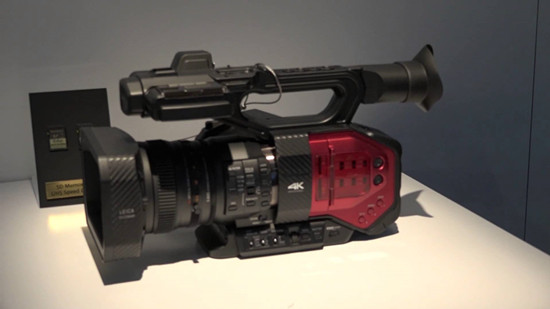 Panasonic AG-DVX200 is a hot 4K hand held camcorder announced this year. Are you planning to get one? Well, before buying one, some guys are eager to know the Panasonic AG-DVX200 4K to FCP workflow so as to have a smooth post production on Mac OS X Yosemite.Panasonic AG-DVX200 captures 4K videos in MP4/MOV format. Based on our testing, when transfer Panasonic AG-DVX200 4K video to FCP, the importing issues always occurred. Although it has been possible to create 4K timelines in Final Cut Pro X, smooth editing of 4K footage in FCP X still requires instant playback of more than one stream of video footage at once.The basic reason is that although FCP X 10.1. has been updated for the next-generation architecture in the new Mac Pro, providing unprecedented performance when editing and monitoring 4K video. Final Cut Pro X natively supports 4K ProRes, Sony XAVC and REDCODE RAW. However, the old version FCP X or Final Cut Pro 6/7 like many editors use 1080p as primary delivery format and will continue to do so for a long time. And the MP4/MOV video from Panasonic DVX200 seems to beyond the format compatibility of Final Cut Pro.To make it easier for editing Panasonic AG-DVX200 4K MP4/MOV in FCP 7/X, you’d better to convert 4K to Apple ProRes first, as it is the best codec for Final Cut Pro editing. There are numbered tools and utilities can convert and compress the ultra HD videos, few of them can process at a fast speed. Pavtube Video Converter for Mac is considered to be the best 4K video converting tool. It can help you to convert Panasonic AG-DVX200 4K MP4/MOV to FCP, iMovie, Adobe Premiere Pro, Avid Media Composer and more editing programs compatible format like Apple ProRes, Apple InterMediate Codec, MPEG-2, DNxHD, etc.
Panasonic AG-DVX200 is a hot 4K hand held camcorder announced this year. Are you planning to get one? Well, before buying one, some guys are eager to know the Panasonic AG-DVX200 4K to FCP workflow so as to have a smooth post production on Mac OS X Yosemite.Panasonic AG-DVX200 captures 4K videos in MP4/MOV format. Based on our testing, when transfer Panasonic AG-DVX200 4K video to FCP, the importing issues always occurred. Although it has been possible to create 4K timelines in Final Cut Pro X, smooth editing of 4K footage in FCP X still requires instant playback of more than one stream of video footage at once.The basic reason is that although FCP X 10.1. has been updated for the next-generation architecture in the new Mac Pro, providing unprecedented performance when editing and monitoring 4K video. Final Cut Pro X natively supports 4K ProRes, Sony XAVC and REDCODE RAW. However, the old version FCP X or Final Cut Pro 6/7 like many editors use 1080p as primary delivery format and will continue to do so for a long time. And the MP4/MOV video from Panasonic DVX200 seems to beyond the format compatibility of Final Cut Pro.To make it easier for editing Panasonic AG-DVX200 4K MP4/MOV in FCP 7/X, you’d better to convert 4K to Apple ProRes first, as it is the best codec for Final Cut Pro editing. There are numbered tools and utilities can convert and compress the ultra HD videos, few of them can process at a fast speed. Pavtube Video Converter for Mac is considered to be the best 4K video converting tool. It can help you to convert Panasonic AG-DVX200 4K MP4/MOV to FCP, iMovie, Adobe Premiere Pro, Avid Media Composer and more editing programs compatible format like Apple ProRes, Apple InterMediate Codec, MPEG-2, DNxHD, etc.
 How to import Panasonic AG-DVX200 4K to FCP 7/X for editing?Step 1: Download and have a quick installation. The trial version will have a watermark on your converted files. Except for that, there are no time limitation, no virus, and no unnecessary bundle apps while downloading. After that, click “Add Video” button to load your 4K files. You can load several files at once thanks to “Add from folder” button.
How to import Panasonic AG-DVX200 4K to FCP 7/X for editing?Step 1: Download and have a quick installation. The trial version will have a watermark on your converted files. Except for that, there are no time limitation, no virus, and no unnecessary bundle apps while downloading. After that, click “Add Video” button to load your 4K files. You can load several files at once thanks to “Add from folder” button.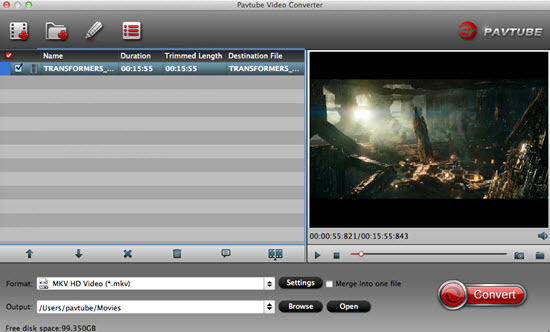 Step 2: Click the “Format” bar to get the drop-down menu and you can get “Final Cut Pro”. Choose “Apple ProRes 422 (*.mov)” as output format.
Step 2: Click the “Format” bar to get the drop-down menu and you can get “Final Cut Pro”. Choose “Apple ProRes 422 (*.mov)” as output format. Step 3: It’s optional to edit video files before converting. If you want to do some edit work, just hit the clip first, and then click “Edit selected task” button. As it’s shown to us, the edit function is sufficient for you to make your videos wonderful.Step 4: Click “Convert” button on the bottom of the screen to start 4K files to ProRes 422 MOV conversion process. The amount of time it takes will vary based on your system’s hardware and the quality settings you selected.Conclusion: When the conversion is done, you can click “Open” button to get the generated video files. Now, you can edit Panasonic AG-DVX200 4K files in FCP 7/X freely.Further Reading:
Step 3: It’s optional to edit video files before converting. If you want to do some edit work, just hit the clip first, and then click “Edit selected task” button. As it’s shown to us, the edit function is sufficient for you to make your videos wonderful.Step 4: Click “Convert” button on the bottom of the screen to start 4K files to ProRes 422 MOV conversion process. The amount of time it takes will vary based on your system’s hardware and the quality settings you selected.Conclusion: When the conversion is done, you can click “Open” button to get the generated video files. Now, you can edit Panasonic AG-DVX200 4K files in FCP 7/X freely.Further Reading:























